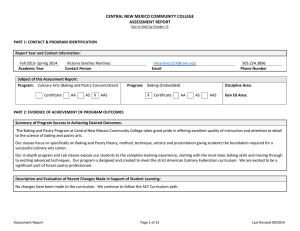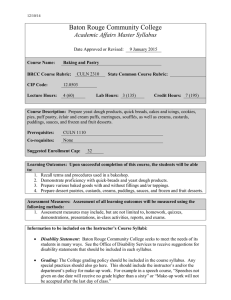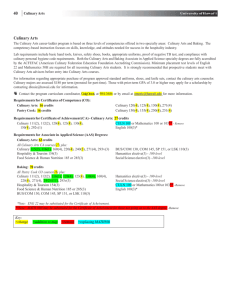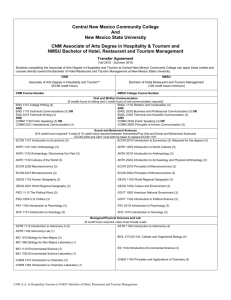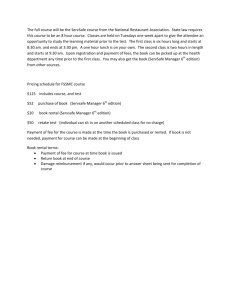Culinary Arts, Culinary Arts Concentration - AAS
advertisement
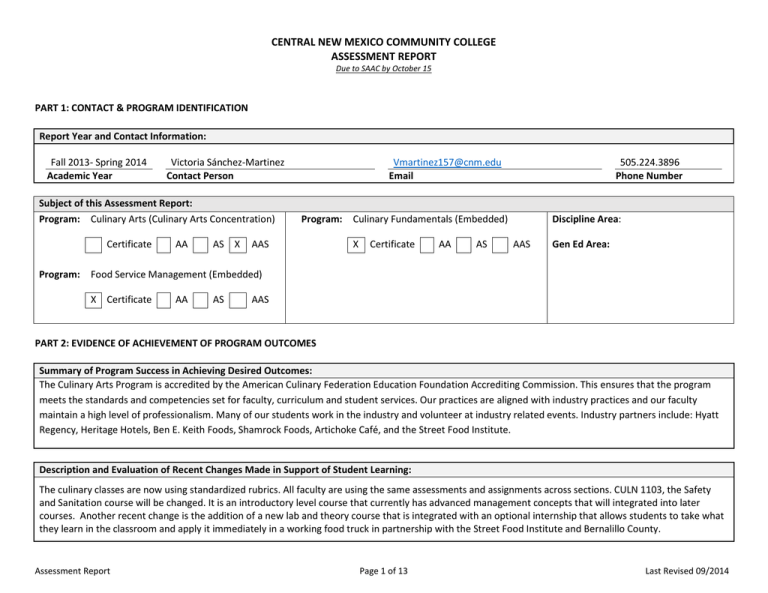
CENTRAL NEW MEXICO COMMUNITY COLLEGE ASSESSMENT REPORT Due to SAAC by October 15 PART 1: CONTACT & PROGRAM IDENTIFICATION Report Year and Contact Information: Fall 2013- Spring 2014 Academic Year Victoria Sánchez-Martinez Contact Person Subject of this Assessment Report: Program: Culinary Arts (Culinary Arts Concentration) Certificate AA AS X Vmartinez157@cnm.edu Email 505.224.3896 Phone Number Program: Culinary Fundamentals (Embedded) AAS X Certificate AA AS Discipline Area: AAS Gen Ed Area: Program: Food Service Management (Embedded) X Certificate AA AS AAS PART 2: EVIDENCE OF ACHIEVEMENT OF PROGRAM OUTCOMES Summary of Program Success in Achieving Desired Outcomes: The Culinary Arts Program is accredited by the American Culinary Federation Education Foundation Accrediting Commission. This ensures that the program meets the standards and competencies set for faculty, curriculum and student services. Our practices are aligned with industry practices and our faculty maintain a high level of professionalism. Many of our students work in the industry and volunteer at industry related events. Industry partners include: Hyatt Regency, Heritage Hotels, Ben E. Keith Foods, Shamrock Foods, Artichoke Café, and the Street Food Institute. Description and Evaluation of Recent Changes Made in Support of Student Learning: The culinary classes are now using standardized rubrics. All faculty are using the same assessments and assignments across sections. CULN 1103, the Safety and Sanitation course will be changed. It is an introductory level course that currently has advanced management concepts that will integrated into later courses. Another recent change is the addition of a new lab and theory course that is integrated with an optional internship that allows students to take what they learn in the classroom and apply it immediately in a working food truck in partnership with the Street Food Institute and Bernalillo County. Assessment Report Page 1 of 13 Last Revised 09/2014 PART 3: REPORT ON RECENT ASSESSMENT OF STUDENT LEARNING PROCESSES Learning Outcome(s)/Exit Competencies Assessed: Classes/Cohorts Assessed: To add rows: right –click in cell below and select “Insert,” “Insert Rows Above” (1) Demonstrate the ability to prepare a variety of hot and cold food products according to standard recipes as well as application of basic cooking methods using proper knife, tool, and equipment techniques. CULN 1110 Fall 2013 and Spring 2014 CULN 1112 Fall 2013 and Spring 2014 (Degree and CULN fundamentals only) CULN 1103 Fall 2013 and Spring 2014 (3) Demonstrate hygiene and sanitation standards in a kitchen setting. Describe basic principles of sanitation, safety, and procedures to determine and monitor critical control points in a professional food service setting. CULN 1110 Fall 2013 and Spring 2014 CULN 1112 Fall 2013 and Spring 2014 (Degree and CULN fundamentals only) CULN 1132 Fall 2013 and Spring 2014 (Degree only) (7) Describe and evaluate procedures for proper receiving, storage, and control of food and non-food items; apply knowledge and quality standards and regulations to purchasing decisions. (Degree and FSMG certificate only) CULN 1103 Fall 2013 and Spring 2014 Measurement Tool(s) Used: Initial Achievement Target or Expectation: X X Rubric score: 75% of students achieve score of 3 or higher (3) Practical Cooking finals using standardized rubrics (hygiene/sanitation standards) X X Rubric score: 75% of students achieve score of 3 or higher Indirect (1) Practical Cooking finals using standardized rubrics Direct To add rows: right –click in cell below and select “Insert,” “Insert Rows Above” Internal External Enter X’s for type of tool HT 2215 Fall 2013 and Spring 2014 (3) ServSafe Food Manager Standardized Exam (total score) X X 80% of students taking exam pass (i.e. score 75% or higher) (7) ServSafe Food Manager Standardized Exam (domain score for Receipt/Storage/Transport of food) (Degree and FSMG certificate only) X X 75% of students score 75% or higher on domain score for Receipt/Storage/Transport of food on ServSafe Food Manager Standardized Exam X Rubric score: 75% of students achieve score of 3 or higher (7) Targeted exam/homework questions(Degree and FSMG certificate only) Assessment Report X Page 2 of 13 Last Revised 09/2014 Assessment Results/Findings: Outcome #1 (Cooking): Demonstrate the ability to prepare a variety of hot and cold food products according to standard recipes as well as application of basic cooking methods using proper knife, tool, and equipment techniques Practical cooking rubric: CULN 1110, CULN 1112 Performance or Objective Below CNM Standards Beginning Developing Accomplished Exemplary 1 2 3 4 0 Demonstrate the ability to prepare a variety of hot and cold food products. Is not able to produce food that is safe to eat, flavorful, cooked correctly, and/or presented properly within class time. Less than 50% of the time, produces food that is safe to eat, flavorful, cooked correctly, and presented properly within class time. More than 50% of the time produces food that is safe to eat, flavorful, cooked correctly, and presented properly within class time. At least 75% of the time produces food that is safe to eat, cooked correctly, flavorful, and presented properly within class time. With a professional sense of urgency, consistently produces food that is safe to eat, cooked correctly, flavorful, properly and creatively presented, within class time, and adopt problem-solving techniques to achieve this. Demonstrate the ability to read recipes and successfully produce the correct end-product. Is not able to read recipes and successfully produce the correct end-product. Less than 50% of the time, can read and successfully complete recipes within class time. More than 50% of the time is able to read and successfully complete recipes within class time. At least 75% of the time is able to read and successfully complete recipes within class time. With a professional sense of urgency, is consistently able to read and successfully produce end-results from recipes, and adopt problemsolving techniques to achieve this. Demonstrate correct knife, tool, and equipment skills and techniques. Is not able to correctly and safely use knives, tools, & equipment. Correctly and safely uses knives, tools, & equipment less than 50% of the time. Correctly and safely uses knives, tools, & equipment more than 50% of the time. Correctly and safely uses, and maintains, knives, tools, & equipment at least 75% of the time. With a professional sense of urgency, consistently uses, sharpens and maintains knives, tools, and equipment correctly, and adopt problem-solving techniques to achieve this. Results (all sections reporting; target: 75% of students scoring a “3” or “4” on rubric): Assessment Report Page 3 of 13 Last Revised 09/2014 Performance level Demonstrate the ability to read recipes and successfully produce the correct endproduct. Demonstrate the ability to prepare a variety of hot and cold food products. Course/section: CULN 1110 all sections 0 0 0 0 1 1 1 0 2 5 6 1 3 35 31 32 4 33 36 41 N 74 91.89% 74 90.54% 74 98.65% % students meeting target (3 or 4) Performance level Demonstrate the ability to read recipes and successfully produce the correct endproduct. Demonstrate the ability to prepare a variety of hot and cold food products. Course/section: CULN 1112 all sections 0 0 0 1 0 0 0 2 2 3 6 3 16 18 21 4 22 19 13 N 40 95.00% 40 92.50% 40 85.00% Performance level Demonstrate the ability to read recipes and successfully produce the correct endproduct. Demonstrate the ability to prepare a variety of hot and cold food products. Course/section: Assessment Report Demonstrate correct knife, tool, and equipment skills and techniques. 0 % students meeting target (3 or 4) CULN 1110/1112 all sections Demonstrate correct knife, tool, and equipment skills and techniques. Demonstrate correct knife, tool, and equipment skills and techniques. 0 0 0 0 1 1 1 0 2 7 9 7 Page 4 of 13 Last Revised 09/2014 3 51 49 53 4 55 55 54 N 114 92.98% 114 91.23% 114 93.86% % students meeting target (3 or 4) Outcome #3 (Safety and Sanitation): Demonstrate hygiene and sanitation standards in a kitchen setting. Describe basic principles of sanitation, safety, and procedures to determine and monitor critical control points in a professional food service setting. Practical sanitation rubric: CULN 1110, CULN 1112, CULN 1132 Below CNM Standards Beginning Developing Accomplished Exemplary 0 1 2 3 4 Uniform and Hygiene Evidence that student is unaware of uniform requirements or proper hygiene procedures More than two modifications to uniform or person was necessary Two modifications were needed (complete uniform not present, personal hygiene not satisfactory Uniform was clean and complete at least 90 % of the time. On a regular basis, the student arrived to class in complete uniform clean and pressed, hair fully restrained, hand and nails clean and trimmed Workstation Evidence that student is unaware of proper station setup and/or sanitation standards Poorly maintained, cross contamination and/or unsanitary conditions present. Tools not cleaned/ sanitized between use. Not well maintained during observation, some knowledge present. Several incidences of unclean/ not sanitized tools/equipment Moderately clean work space, one or two incidences of issues of unclean/ not sanitized tools equipment Exceptional clean and sanitary area, no cross contamination evidence or unsanitary conditions Tools and Equipment Evidence student unaware of safe and/or proper use of tools and equipment Improper use of tools and/or equipment was shown More than two observations made of careless or improper use of tools and equipment Illustrated proper use of tools and equipment in a safe manner at least 90% of the time. Complete compliance with all safe use of tools and equipment Work Habits Evidence that student is unaware of proper work habits Frequently touched hair, face, reaching into pockets. Little concern for Poor hand washing frequency, general cleanliness not evident Frequently washed hands, minimal incidences of hair/face Extreme care given to person; no incidences of touching face, hair or unclean surfaces Assessment Report Page 5 of 13 Last Revised 09/2014 cleanliness. Missed frequent hand washing Cleanup Evidence student is unaware of proper methods for cleaning and sanitizing tools and workstation Equipment and tools not cleaned/ sanitized, or put away. Touching Most tools and area not clean/sanitized, or put away. One or two tools / equipment not cleaned, sanitized and put away. Observation showed all compliance with tools, area and equipment Results (all sections reporting; target: 75% of students scoring a “3” or “4” on rubric): Course/section: CULN 1110 all sections Performance Uniform and level Hygiene CULN 1112 all sections CULN 1132 all sections Assessment Report Work Habits Cleanup 0 0 0 0 0 1 0 0 0 0 0 2 2 7 2 5 6 3 20 22 23 22 24 4 52 45 49 47 44 N 74 97.30% 74 90.54% 74 97.30% 74 93.24% 74 91.89% Performance Uniform and level Hygiene Workstation Tools and Equipment Work Habits Cleanup 0 0 0 0 0 0 1 0 0 0 0 0 2 3 0 14 2 0 3 16 15 19 21 13 4 21 25 7 17 27 N 40 92.50% 40 100.00% 40 65.00% Performance Uniform and level Hygiene Workstation Tools and Equipment 0 0 % students meeting target (3 or 4) Course/section: Tools and Equipment 0 % students meeting target (3 or 4) Course/section: Workstation 0 0 Page 6 of 13 40 40 95.00% 100.00% Work Habits 0 Cleanup 0 Last Revised 09/2014 1 0 0 0 0 0 2 3 0 0 3 0 3 13 17 12 17 14 4 23 22 26 19 25 N 39 92.31% 39 100.00% 39 97.44% Performance Uniform and level Hygiene Workstation Tools and Equipment % students meeting target (3 or 4) Course/section: CULN 1110/1112/1132 all sections 39 39 92.31% 100.00% Work Habits Cleanup 0 0 0 0 0 0 1 0 0 0 0 0 2 8 7 16 10 6 3 49 54 54 60 51 4 96 92 82 83 96 N 153 94.77% 153 95.42% 153 88.89% 153 93.46% 153 96.08% % students meeting target (3 or 4) ServSafe Food Manager Standardized Exam (total score) Results (all sections reporting; target: 80% of examinees passing exam): Term No. taking exam Passed (75%) Not passed (<75%) Fall 2013 Spring 2014 57 67 48 (84.2% pass rate) 51 (76.1% pass rate) 9 17 Outcome #7 Purchasing and Receiving: Describe and evaluate procedures for proper receiving, storage, and control of food and non-food items; apply knowledge and quality standards and regulations to purchasing decisions. Tools: Targeted exam/homework questions (objectives 1-3); ServSafe Food Manager Standardized Exam (domain score for Receipt/Storage/Transport of food) (objective 4) Assessment Report Page 7 of 13 Last Revised 09/2014 Objective Measurement tool Below CNM Standards 0 Describe proper procedures for receiving and inspecting product as it enters the facility. Targeted assignment question HT 2215 Perform mathematical operations associated with purchasing and receiving. Targeted assignment question HT 2215 3 Perform mathematical operations associated with purchasing and receiving. 4 Identify standards for safely inspecting and grading of meats, poultry, seafood, eggs, dairy 1 2 Assessment Report Beginning Developing Accomplished Exemplary 1 2 3 4 Did not answer question; did not demonstrate grasp of concept. Assessment missing 1 or more critical components. Assessment missing more than 2 noncritical components. Assessment missing 1-2 noncritical components. Accurate and complete written assessment of receiving procedures. Did not answer question; incorrect procedure and answer. -- Correct procedure followed; minor error in arithmetic -- Accurate computation of cost of error. Targeted exam questions: HT 2215 Accuracy on questions below 71%. -- Accuracy on questions at 7181%. Accuracy on questions at 81-95%. Accuracy on questions at 95% or higher. ServSafe Food Safety Exam Section Domain 3 scores (Receipt/ Accuracy on questions below 75% (9/13 correct -- -- Accuracy on questions at 75-91% (10/13 or Accuracy on questions at 92% or higher (12/13 correct See below See below Page 8 of 13 Last Revised 09/2014 products, fruits and vegetables. Storage/Transport responses or of food) below). 11/13 correct responses). responses or higher). Results: Fall 2013 Performance level 0 1 2 3 4 N % students meeting target (3 or 4) Spring 2014 Assessment Report Food cost essay question HT 2215 Calculate purchasing error HT2215 Exam questions Describe proper procedures for receiving and inspecting product as it enters the facility. Perform mathematical operations associated with purchasing and receiving. Perform mathematical operations associated with purchasing and receiving. 0 0 6 12 8 26 76.92% Food cost essay question HT 2215 0 0 4 22 26 7 7 12 26 84.62% 73.08% Calculate purchasing error HT2215 Page 9 of 13 Exam questions Last Revised 09/2014 Performance level Describe proper procedures for receiving and inspecting product as it enters the facility. 0 1 2 3 4 N % students meeting target (3 or 4) Perform mathematical operations associated with purchasing and receiving. 7 3 14 19 3 45 48.89% Perform mathematical operations associated with purchasing and receiving. 7 2 19 12 14 40 17 46 35.00% 36.96% ServSafe Food Manager Standardized Exam (domain score for Receipt/Storage/Transport of food) Results (all sections reporting; target: 75% of examinees score 75% or higher on domain score for Receipt/Storage/Transport of food): Performance level Fall 2013 Spring 2014 8 22 1 n/a n/a 2 n/a n/a 22 28 0 3 Assessment Report Criteria Accuracy on questions below 75% (9/13 correct responses or below). Accuracy on questions at 75-91% (10/13 or 11/13 correct responses). Page 10 of 13 Last Revised 09/2014 4 Accuracy on questions at 92% or higher (12/13 correct responses or higher). N % students meeting target (3 or 4) 27 12 57 67 85.96 59.70% Analysis and Interpretation of Assessment Results/Findings: ServSafe Food Safety launched a new edition and significantly refocused the content and certification exam. The program needs to evaluate the assessment tools for purchasing and cost control. It may be a difference in instructors from term to term. Continued monitoring over time is essential. Action Plan in Support of Student Learning: The program has only been using the standardized rubrics for one year, additional terms of data collection will offer a comparison and allow for adjustments. Recommendations, Proposals, and/or Funding Requests: PART 4: EMBEDDED OUTCOMES Critical Thinking and Life Skills/Teamwork Development within Programs: a) Please describe how Critical Thinking assessment is embedded within your program assessment. b) Please describe how Life Skills/Teamwork assessment is embedded within your program assessment. a) While most written assignments in both lab and non-lab classes have a critical thinking component, critical thinking in culinary lab classes (CULN 1110, 1112, 1130, 1132, 2214, 2216) is assessed in the student’s ability to plan their execution of recipes within the day’s activities. Most instructors ask students to prepare a written “firing sheet” or plan—similar to what successful cooks use in industry—to detail how they are going to approach a lab session. Some Assessment Report Page 11 of 13 Last Revised 09/2014 instructors require lab students to complete notebooks or reflections asking the student to self-assess their prepared food and submit these materials to instructors. Most instructors calculate these outcomes using rubrics similar to those used for other program outcomes used elsewhere in this report. b) Students in most lab classes are assessed by means of a daily lab grade that includes the student’s attendance, professionalism, teamwork, and level of prior-to-class preparation for the day’s activities. Most instructors calculate these outcomes using rubrics similar to those used for other program outcomes used elsewhere in this report. PART 5: ASSESSMENT CYCLE PLAN (Copy and paste from original plan if unchanged) Cycle Years: Plan Description: 2011-2017 Our assessment plan for the AAS in Culinary Arts as well as its two embedded certificates, is designed to measure a variety of outcomes we have determined are necessary for success upon graduation and that also measure our compliance with our accrediting body’s (American Culinary Federation Educational Foundation) “Knowledge and Competencies.” Some outcomes will be measured at various points in the program to provide assessment of how our students are progressing. Some outcomes are simply measured at a single point because they are measured by standardized testing or are primarily taught in only one course. Minor changes and corrections to the timeline and courses for assessment relative to last year’s plan have been made to reflect changes in course-level outcomes and to the course catalog. Student Learning Outcomes/Exit Competencies: When Measured: Where Measured: How Measured: 1. Demonstrate the ability to prepare a variety of hot and cold food products according to standard recipes as well as application of basic cooking methods using proper knife, tool, and equipment techniques. 2011-2017 CULN 1110 2015-2017 CULN 1112 (Degree and CULN fundamentals only) Practical Finals utilizing standardized rubrics (direct/internal); assessment measurement tool to be determined for CULN 2214 2. Demonstrate knowledge of the fundamentals of baking science by preparing a variety of products according to standard recipes using proper hand, tool, and equipment techniques. (Degree only) 2014-2017 CULN 2214 (Degree only) 3. Demonstrate hygiene and sanitation standards in a 2011-2017 kitchen setting. Describe basic principles of sanitation, safety, and procedures to determine and monitor critical control points in a professional food 2011-2017 service setting. 2015-2017 Assessment Report CULN 1130, 1132 (Degree only) Practical Finals utilizing standardized rubrics (direct/internal) CULN 1103 ServSafe Standardized Exam(direct/external) CULN 1110 Page 12 of 13 Practical Finals utilizing standardized rubrics (direct/internal); assessment measurement tool to be determined for CULN 2214 Last Revised 09/2014 CULN 1112 (Degree and CULN fundamentals only) CULN 1130 (Degree only) CULN 2214 (Degree only) 4. Describe the elements of a high quality customer service system; perform dining room service functions using a variety of types of service. (Degree and Cert. FSMG only) 2014-2017 HT 1164 2015-2017 CULN 2216 (Degree only) 5. Describe and evaluate organizational structures, leadership styles, and personnel management techniques as they apply to a wide variety of hospitality operations. (Degree and Cert. FSMG only) 2015-2017 HT 2201 ManageFirst Exam (direct/external); HT 2201 Final Project (direct/internal) (tentative) 6. Identify styles, production methods and service of a 2014-2017 variety of alcoholic and non-alcoholic beverages; 2015-2017 explain laws and procedures related to responsible alcohol service. (Degree and Cert. FSMG only) HT 1164 ServSafe Alcohol Exam Score (direct/external) 7. Describe and evaluate procedures for proper 2013-2017 receiving, storage, and control of food and non-food items; apply knowledge and quality standards and regulations to purchasing decisions. (Degree only) CULN 1103 8. Describe the characteristics, functions, and food 2016-2017 sources of the major nutrients and how to maximize nutrient retention in food preparation and storage. NUTR 1010; CULN 1110/1112 CULN 2216 (Degree only) HT 1164 Customer Service Exam Score (direct/external); assessment measurement tool to be determined for CULN 2216 assessment measurement tool to be determined HT 2215 Domain 3 scores (Receipt/Storage/Transport of food) in ServSafe Food Safety Exam(direct/external) targeted assignment and exam questions (direct/internal) Assessment measures to be determined (Degree and Cert. FSMG only) Assessment Report Page 13 of 13 Last Revised 09/2014
